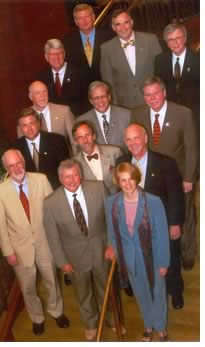

08/2004
NCARB Passes ARE “Rolling Clock” Requirement
 The
National Council of Architectural Registration Boards (NCARB) passed several
measures at its annual business meeting June 26 in Portland, Ore., including
implementation of a five-year “rolling clock” for completion
of the Architectural Registration Exam (ARE). The new rolling clock requirement
allows licensure candidates five years to complete all portions of the
ARE. Currently, 14 jurisdictions have imposed various time limits for
completion of the ARE, ranging from three years in Maine to eight years
in Washington, D.C. NCARB intends this resolution to resolve differing
requirements among the states and strengthen the validity of the exam.
The
National Council of Architectural Registration Boards (NCARB) passed several
measures at its annual business meeting June 26 in Portland, Ore., including
implementation of a five-year “rolling clock” for completion
of the Architectural Registration Exam (ARE). The new rolling clock requirement
allows licensure candidates five years to complete all portions of the
ARE. Currently, 14 jurisdictions have imposed various time limits for
completion of the ARE, ranging from three years in Maine to eight years
in Washington, D.C. NCARB intends this resolution to resolve differing
requirements among the states and strengthen the validity of the exam.
 In
discussing his agenda, incoming NCARB President Frank Guillot, FAIA, indicated
that during his term of office, NCARB will continue to expand its efforts
on the international front. He also emphasized that the council will increase
the scope of its Reciprocity Task Force in 2005 by examining impediments
to multi-state firm practice. Guillot also commented that the Council’s
Broadly Experienced Architect Committee is continuing to develop an initiative—now
in the developmental stage—that will allow qualified foreign architects
to apply for the NCARB Certificate.
In
discussing his agenda, incoming NCARB President Frank Guillot, FAIA, indicated
that during his term of office, NCARB will continue to expand its efforts
on the international front. He also emphasized that the council will increase
the scope of its Reciprocity Task Force in 2005 by examining impediments
to multi-state firm practice. Guillot also commented that the Council’s
Broadly Experienced Architect Committee is continuing to develop an initiative—now
in the developmental stage—that will allow qualified foreign architects
to apply for the NCARB Certificate.
Actions on Resolutions Presented at the 2004 NCARB Annual Meeting and Conference
- Resolution 04-1: “Model Law Amendment—Prototype
Building Documents.”
Passed: 34–18. - Resolution 04-2: “Handbook for
Interns and Architects—Rolling Five Year Clock.”
Passed: 45–7. - Resolution 04-3: “Bylaw Amendment—Allowance
for President and First Vice President.”
Passed: 49–1. - Resolution 04-4: “Bylaw Amendment—Exam
Administration Corrective Changes.”
Passed: 51–1. - Resolution 04-5: “Model Law Amendment—Retired
Architects.”
Passed: 51–1. - Resolution 04-6: “Bylaw Amendment—Committee
on Procedures and Documents Membership.”
Passed: 52–0. - Resolution 04-7: “BEA—Amendment
to Handbook for Interns and Architects and NCARB Education Standard.”
Passed: 49–3. - Resolution 04-8: “Acknowledge
and Respond to the Final Report of the Collateral Internship Management
Group.”
Withdrawn by Region 3.
Copyright 2004 The American Institute of Architects.
All rights reserved. Home Page ![]()
![]()
 |
||
| AIA President Eugene Hopkins, FAIA, and several members of national AIA component staff represented the Institute at the meeting. Pictured in the photo are the members of the 2004–2005 NCARB Board of Directors. Front Row: John F. Miller, FAIA (Mass.); Peter T.S. Rasmussen, FAIA (Wash.); Executive Vice President Lenore M. Lucey, FAIA. Second row: Steven T. Ellinger, AIA (Tex.); Past President Robert A. Boynton, FAIA (Va.); First Vice President H. Carelton Godsey, AIA (N.Y.). Third row: Frank M. Adams, AIA (Pa.); Scott C. Veasey, AIA (Ind.); Secretary Douglas K. Engebretson, FAIA (Mass.). Fourth row: Stan Peterson, AIA (Kan.); Second Vice President Robert E. Luke, AIA (Miss.); President Frank Guillot, FAIA (Vt.); and Treasurer Gordon E. Mills, FAIA (Iowa).
|
||